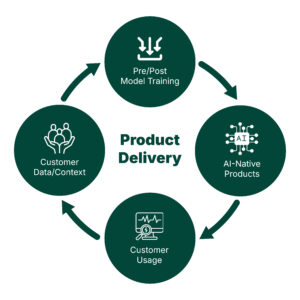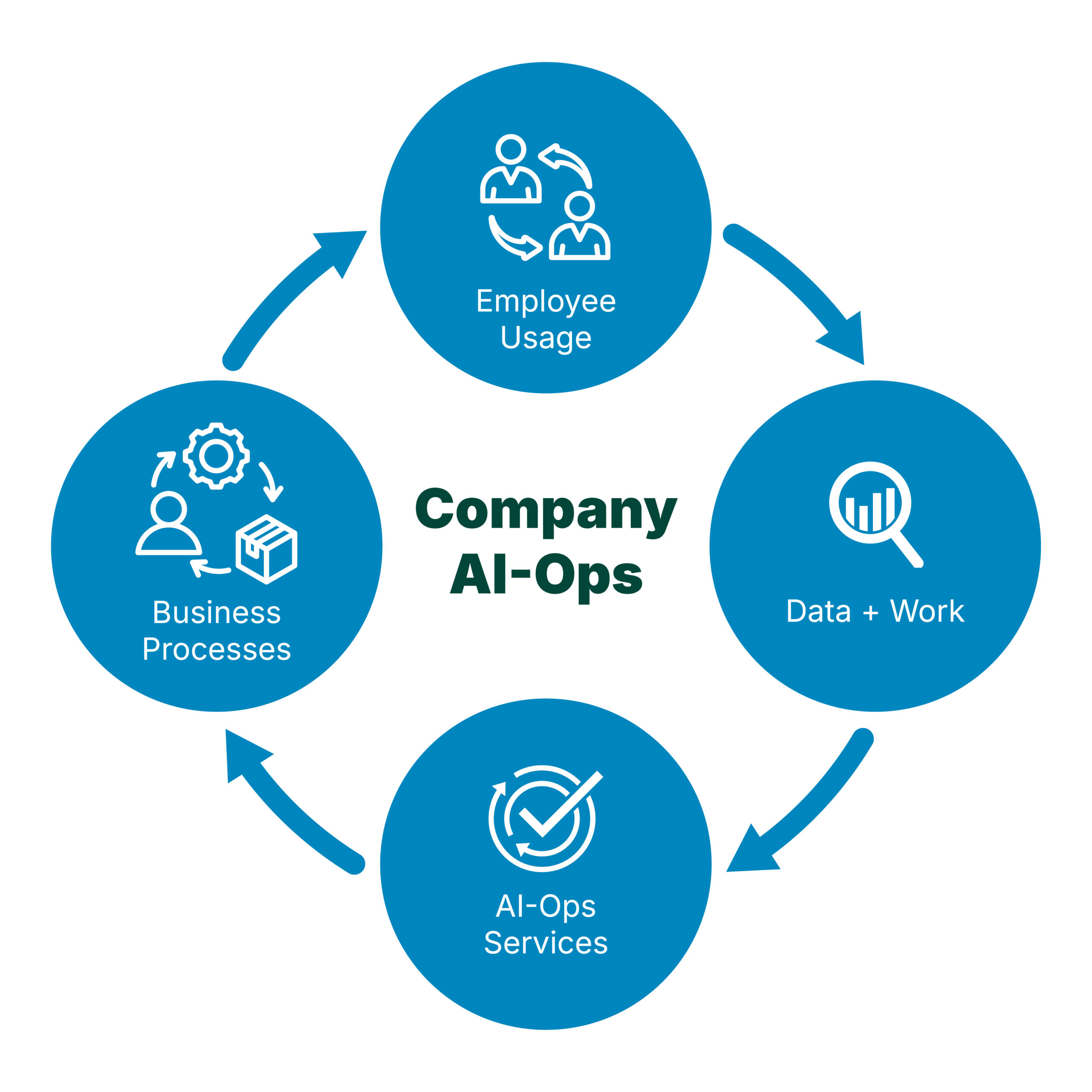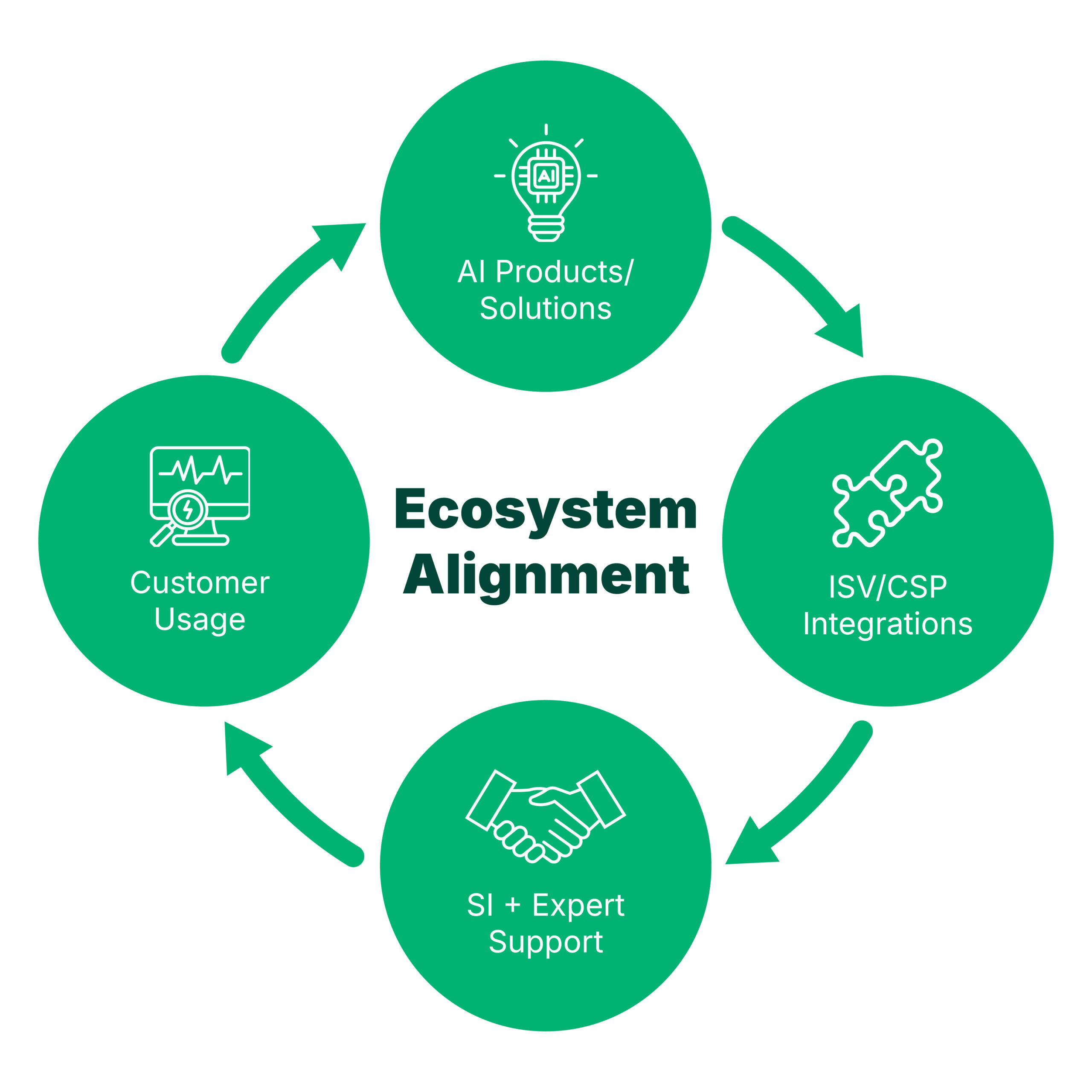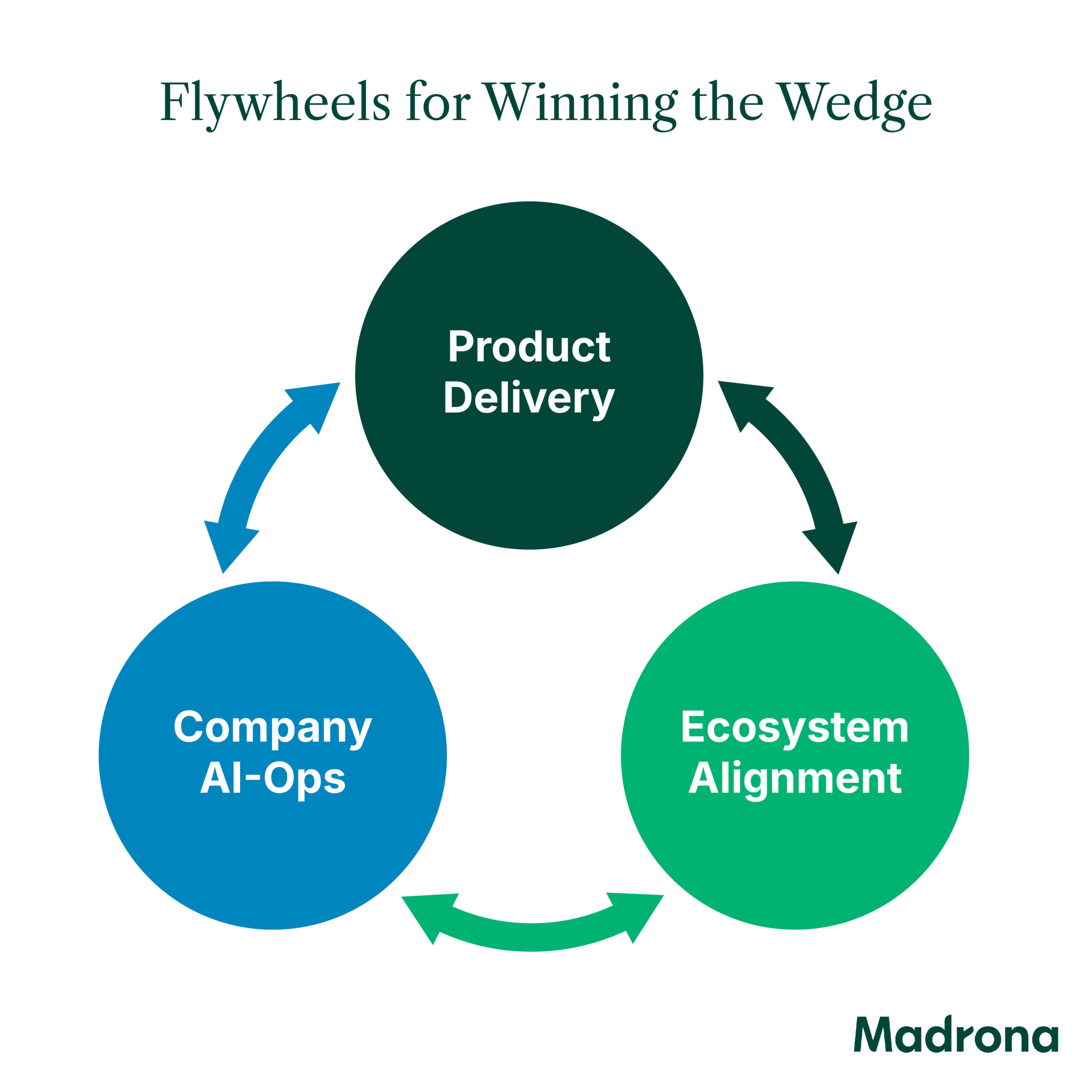AI-native companies are rapidly winning customer wedges — but are they building durable businesses?
Unprecedented access to “intelligence” has unleashed a wave of invention, with companies gaining impressive market traction and nimble teams rapidly shipping products that look magical and attract real customers. But here’s the catch: early traction doesn’t equal durable advantage.
The very AI forces fueling breakthrough velocity — abundant model access, open tools, AI-enhanced employees — also make it easier than ever to be outpaced or copied. So, how do founders build staying power when disruption and durability seem at odds?
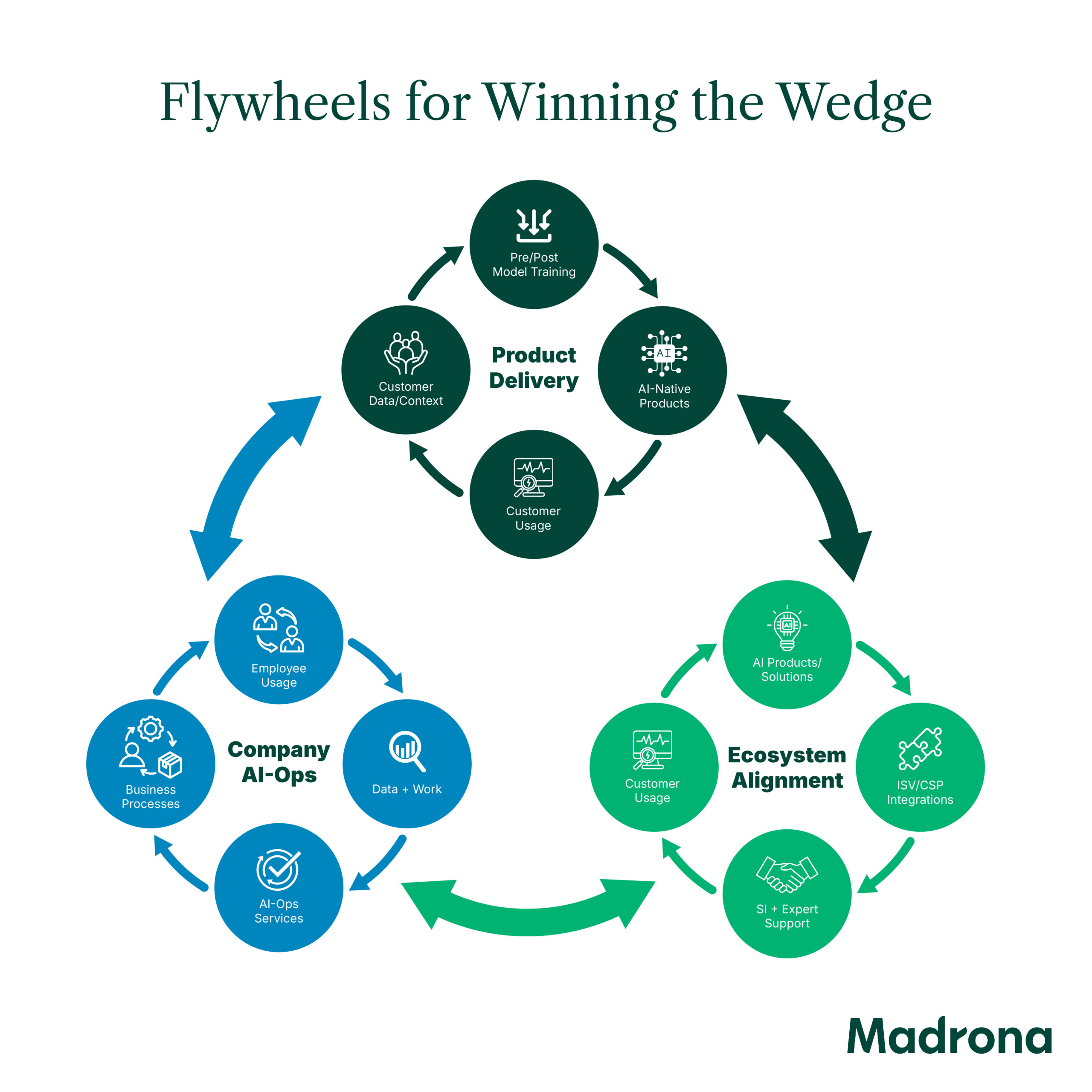 It starts with winning a customer wedge and maniacally focusing on owning it. Then comes the real work: compounding value over time. The companies that endure aren’t just fast; they build complementary flywheels that leverage initial customer traction and reinforce their wedge through how they deliver products, operate internally, and grow their ecosystem. These aren’t just mechanisms for scale — they form the foundation for long-term defensibility.
It starts with winning a customer wedge and maniacally focusing on owning it. Then comes the real work: compounding value over time. The companies that endure aren’t just fast; they build complementary flywheels that leverage initial customer traction and reinforce their wedge through how they deliver products, operate internally, and grow their ecosystem. These aren’t just mechanisms for scale — they form the foundation for long-term defensibility.
Having curated the list of the top 40 private AI companies each of the past four years (see www.ia40.com), we have seen firsthand how tough the durability challenge is for founders. Only four IA40 winners have made the list all four years, and about 50% of the companies are replaced each year. This level of churn reflects a broader truth: it’s one thing to win early — it’s another to stay ahead and ultimately define a market.
So, how can founders iteratively build their way toward durable growth?
This post outlines a playbook for building three AI flywheels and using them to scale beyond your initial wedge. If you’re building an AI-native company, this is the framework for long-term advantage.
The Product Delivery Flywheel
Company success starts with deeply understanding customers who have a problem and urgently need a solution. For AI-native startups, a differentiated, continually improving product is the most important first engine of growth, which is where the product delivery flywheel comes in.
Startups face major disadvantages compared to incumbents as they don’t have the existing training data, user context, or structured workflows to easily create agentic applications. Instead, they must bootstrap the data and context by leveraging frontier models, public data, and open-source tools. The opportunities for differentiation lie in owning a wedge use case, optimizing across multiple models and agents, leveraging unstructured and structured data sources, and working across existing formal and informal business processes.
AI-native products are architected to improve with use in a way traditional software isn’t. The product flywheel works like this: data/context → better product → more users → better data/context → better product. It’s an iterative feedback loop where every user interaction improves relevance, speed, and personalization.
While products can be bootstrapped with Services as Software, durable winners evolve into truly AI-centric products with a highly automated product flywheel that improves with use. Without this, new, more cost-effective entrants with better automation and agentic workflows will emerge and outpace them.
Building the product flywheel starts by targeting early adopters, architecting for feedback capture, and refining models (including post-training) as new efficacy signals are gathered. Emerging technology standards, including MCP, frontier model improvements, and advances in post-training, make it possible for innovative wedge solutions to emerge and establish initial advantage.
The Company AI-Operations Flywheel
An early product wedge is critical — but it’s not enough. AI-native companies also need an internal operations flywheel to scale sustainably.
AI-native operations start with engineering teams using AI coding tools (Cursor, Codeium) and low-code/no-code approaches (V0, Bolt.new). The marketing teams must use “swarm intelligence” to iterate and personalize top-of-funnel marketing and content while also learning how SEO evolves to “Model Recommendation Optimization” (MRO) to support customer discovery. Operations leaders must weave structured and unstructured data into cross-functional workflows that improve over time.
AI-native companies can scale with fewer people, move faster, and reduce overhead — but only if they adopt a first-principles approach across internal data types (structured and unstructured), business functions, and software tools. And that shift is leading to something bigger: roles inside companies are blurring. With AI systems doing more low-level tasks, people can do things they couldn’t do before. It’s not just productivity — it’s creativity. This unlocks new ideas, new ways of working, and entirely new workflows.
Embracing the power of internal AI workflows improves both effectiveness (doing things better) and efficiency (doing things faster). For example, digitally transcribing fifty customer interviews, extracting product learnings, and then identifying product priorities, you can build and launch a customer-centric product more rapidly. This operating mindset gives AI-native startups an advantage over incumbents — who, despite their customer bases and datasets, are constrained by legacy processes.
Change is already happening — Shopify, for example, is embracing AI-native business processes. In addition, my informal survey of early-stage founders, younger bankers/investors, and management consultants indicates they are finding tremendous benefits from using AI technologies to do substantial portions of their work. When incumbent companies and younger professionals already embrace emerging technologies to do their jobs better, broader adoption is coming soon.
The Ecosystem Alignment Flywheel
Once the product and company flywheels are spinning, the ecosystem flywheel becomes critical — and it’s essential for long-term durability and moat building.
When an AI company focuses successfully on a narrow wedge, it clarifies ecosystem partner priorities. One example is Gradial, a Madrona-backed company that provides marketing content execution for enterprise customers. They primarily help customers update websites, starting with multi-modal (text, images, Figma files) content requests that are processed through the Gradial AI agent into updates to Content Management Systems like Adobe Experience Manager.
Gradial focuses on enterprise customers and operates on multiple Cloud Service Providers (CSPs), leveraging diverse AI models. The content execution process for enterprises is far more complex than many appreciate – brand standards, global languages, image rights, content modalities/formats, and more — all come into play. Solutions also often involve systems integrators (SIs) and service providers such as Accenture, Deloitte, or Slalom. Gen-native startups bring agility, creativity, and innovation. The SIs bring access, trust, and embedded distribution. Together, they make each other stronger. Gradial’s early ecosystem alignment with Adobe, Amazon, and Prudential shows the power of this approach.
Stepping back, the key on the ecosystem front is to create alignment across all external parties you work with as an AI-native company. Building an ecosystem flywheel means aligning CSPs, model providers, incumbent software partners, and SIs around your wedge. Customer momentum draws integration partners, and successful integrations attract SIs to help with change management and modernization.
Executed well, the ecosystem flywheel accelerates case studies, conference opportunities, integrations, joint sales — and ultimately customer wins. And as always, customer wins feed back into product flywheels via new data and context.
Compounding the Flywheel Advantage
The overall goal here is far beyond building an AI-native product — it’s to win a customer wedge, iterate on the three complementary flywheels, and then use those flywheels to expand into adjacent markets.
I don’t believe companies will maintain durable growth by having just one or even two of these flywheels – you must have all three, and they must reinforce each other.
- Product flywheels drive adoption and customer value.
- Company flywheels enable scaling with speed and creativity.
- Ecosystem flywheels build durable advantage through alignment and distribution.
To scale with speed and efficiency, AI-native companies need strong operational muscle. To retain/expand customers, they need adaptive, continually improving products. And to build a more durable business than their competitors (in the initial and subsequent wedges), they need a trusted and aligned ecosystem. When these three flywheels work together, the result is not just growth — it’s compounding market success.
Winning your initial wedge will also not be enough to win the broader market category. In these early innings of the AI transformation, countless companies will try to solve focused customer problems. Early winners will be invited by their customers and ecosystem partners to address adjacent problems. At that point, the importance of AI reasoning and internal processes that complement founder intuition will be critical to making the best strategic judgements: Which wedges should you expand into? Who will be the competition? Who will you partner with? Which data and AI tools will expand your application advantage?
At Madrona, we’ve spent decades investing in and scaling companies from day one — and we’re particularly focused on how the next generation of durable, AI-native companies are being built. We believe these three flywheels — product, company, and ecosystem — are essential to building enduring market leaders.
The most curious and capable founding teams will find ways to build and integrate these flywheels into daily execution and strategic decision-making about market expansion and sustainable growth. I do expect some of these companies will be the next generation of durable market leaders!
